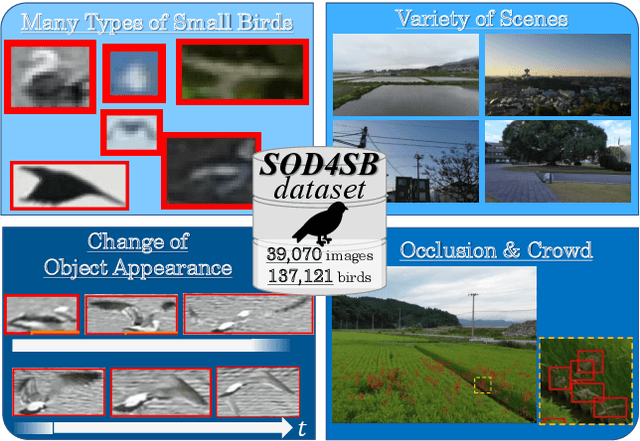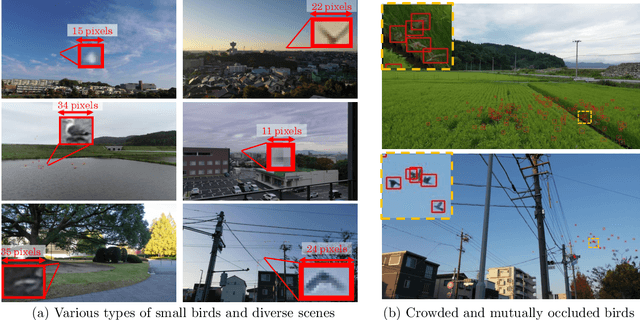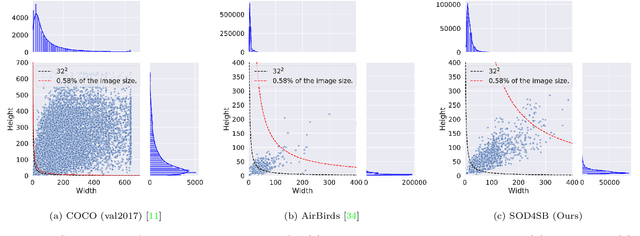Yuki Kondo
NTIRE 2023 Image Shadow Removal Challenge Technical Report: Team IIM_TTI
Mar 15, 2024



Abstract:In this paper, we analyze and discuss ShadowFormer in preparation for the NTIRE2023 Shadow Removal Challenge [1], implementing five key improvements: image alignment, the introduction of a perceptual quality loss function, the semi-automatic annotation for shadow detection, joint learning of shadow detection and removal, and the introduction of new data augmentation technique "CutShadow" for shadow removal. Our method achieved scores of 0.196 (3rd out of 19) in LPIPS and 7.44 (4th out of 19) in the Mean Opinion Score (MOS).
MVA2023 Small Object Detection Challenge for Spotting Birds: Dataset, Methods, and Results
Jul 18, 2023



Abstract:Small Object Detection (SOD) is an important machine vision topic because (i) a variety of real-world applications require object detection for distant objects and (ii) SOD is a challenging task due to the noisy, blurred, and less-informative image appearances of small objects. This paper proposes a new SOD dataset consisting of 39,070 images including 137,121 bird instances, which is called the Small Object Detection for Spotting Birds (SOD4SB) dataset. The detail of the challenge with the SOD4SB dataset is introduced in this paper. In total, 223 participants joined this challenge. This paper briefly introduces the award-winning methods. The dataset, the baseline code, and the website for evaluation on the public testset are publicly available.
Joint Learning of Blind Super-Resolution and Crack Segmentation for Realistic Degraded Images
Feb 27, 2023



Abstract:This paper proposes crack segmentation augmented by super resolution (SR) with deep neural networks. In the proposed method, a SR network is jointly trained with a binary segmentation network in an end-to-end manner. This joint learning allows the SR network to be optimized for improving segmentation results. For realistic scenarios, the SR network is extended from non-blind to blind for processing a low-resolution image degraded by unknown blurs. The joint network is improved by our proposed two extra paths that further encourage the mutual optimization between SR and segmentation. Comparative experiments with SoTA segmentation methods demonstrate the superiority of our joint learning, and various ablation studies prove the effects of our contributions.
Kernelized Back-Projection Networks for Blind Super Resolution
Feb 17, 2023Abstract:Since non-blind Super Resolution (SR) fails to super-resolve Low-Resolution (LR) images degraded by arbitrary degradations, SR with the degradation model is required. However, this paper reveals that non-blind SR that is trained simply with various blur kernels exhibits comparable performance as those with the degradation model for blind SR. This result motivates us to revisit high-performance non-blind SR and extend it to blind SR with blur kernels. This paper proposes two SR networks by integrating kernel estimation and SR branches in an iterative end-to-end manner. In the first model, which is called the Kernel Conditioned Back-Projection Network (KCBPN), the low-dimensional kernel representations are estimated for conditioning the SR branch. In our second model, the Kernelized BackProjection Network (KBPN), a raw kernel is estimated and directly employed for modeling the image degradation. The estimated kernel is employed not only for back-propagating its residual but also for forward-propagating the residual to iterative stages. This forward-propagation encourages these stages to learn a variety of different features in different stages by focusing on pixels with large residuals in each stage. Experimental results validate the effectiveness of our proposed networks for kernel estimation and SR. We will release the code for this work.
 Add to Chrome
Add to Chrome Add to Firefox
Add to Firefox Add to Edge
Add to Edge